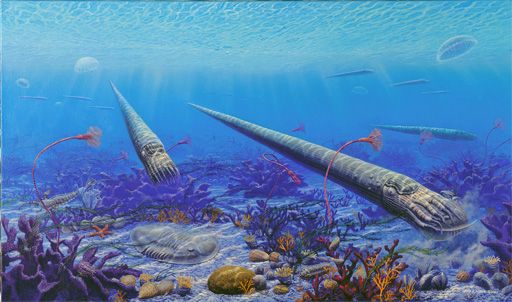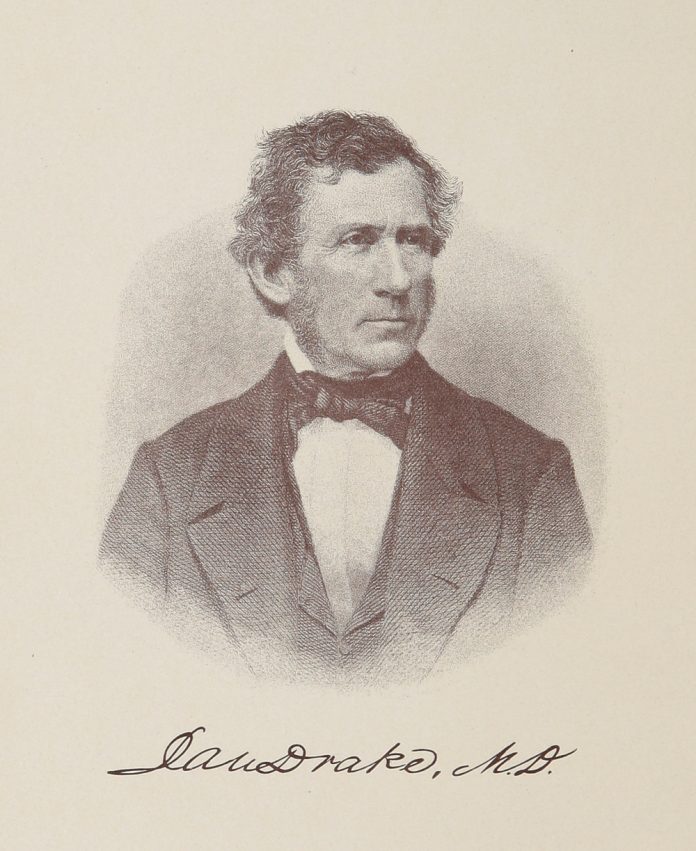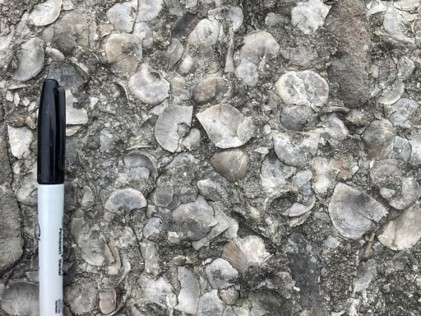
CMC Blog
“The Flœts Shell Limestone”: Celebrating Daniel Drake and 200 Years of Cincinnatian Paleontology
By: Cameron E. Schwalbach, Paleontology Collections Manager, Cincinnati Museum Center
Since their first published reference by Daniel Drake 200 years ago, the fossiliferous rocks exposed throughout the region of Cincinnati, Ohio, have fascinated scientists from around the world, providing a unique natural laboratory in which to examine important aspects of Earth’s history such as evolution, biotic invasion, climate change, sea level change, plate tectonics and landscape evolution. These Late Ordovician rocks, officially known as the Cincinnatian Series, are famous for their well-preserved fossils present in such abundance that they can be readily found in almost any local stream exposure or roadcut. Many decades of study and thousands of publications by both professional scientists and amateur collectors of these rocks and the fossils they contain have collectively painted a picture of a thriving marine ecosystem that once inhabited this region nearly 450 million years ago.

Figure 1. The Cincinnatian, oil on canvas, by John Agnew, 2007. This scene depicts life in the Cincinnati region as it may have appeared during the Ordovician Period, approximately 445 million years ago.
In 1825, the American Philosophical Society published a letter by Dr. Daniel Drake titled, “Geological Account of the Valley of the Ohio: In a Letter from Daniel Drake, M. D. to Joseph Correa de Serra”. In this letter, Drake attempts to generalize some of the “geological phenomena” of the Cincinnati region. He examines everything from river terraces and floodplains to the nature of hillslopes and the characteristics of the rocks, suggesting possible mechanisms that led to their formation. Although written in 1817, the publication of the letter 200 years ago in 1825 with Drake’s reference to the “flœts shell limestone” marked the first time that the fossiliferous Late Ordovician rocks of Cincinnati were referred to in published literature.

Figure 2. Daniel Drake, M.D., lithographic print. Image courtesy of the Public Library of Cincinnati and Hamilton County.
Cincinnati was founded as “Losantiville” in 1788, the name being a portmanteau of Licking River (L), Greek for "mouth" (os), Latin for "opposite" (anti) and French for town (ville). Re-named in 1790 after The Society of Cincinnati (itself named for Cincinnatus, the legendary symbol of Roman civic virtue), Cincinnati was America’s first major boomtown and the first great city west of the Allegheny Mountains; the population of only 750 residents in 1800 grew to over 115,000 by 1850. Universities had not yet been established in the “West” at this time, and the only professional schools were of law and medicine, although several liberal arts colleges in Ohio and Indiana were in place (Denison, Hanover, Earlham, Antioch, Otterbein and Miami “University”). Even so, early Cincinnatians were eager in many ways to distance themselves from the eastern states and Europe and establish their own unique culture. Journalist Edward B. Cooke wrote in 1819 of Cincinnati as “the fair Queen of the West, distinguished for order, enterprise, public spirit, and liberality, she stands the wonder of an admiring world.” She is still known as the “Queen City” today.
Daniel Drake was a pioneering American physician and a prominent figure in Cincinnati history, making contributions to the fields of medicine, geography, geology, meteorology, botany and medical geology, and active in topics from politics and business to culture and social reform. In addition to being Cincinnati’s first historian (Drake published the book “Natural and Statistical View, or Picture of Cincinnati and the Miami Country” in 1815), Drake founded several of Cincinnati’s major institutions, not the least among them the Western Museum Society, established in 1818 for “the illustration of our Natural History…as people in our situation have special need of an acquaintance with their productions and resources.” After two years of fundraising and collections acquisition, the Western Museum, the predecessor to Cincinnati Museum Center’s Museum of Natural History & Science, opened in 1820 as the first public science museum west of the Alleghenies.
Drake’s letter to the Portuguese polymath Joseph Correa de Serra focuses primarily on the processes leading to the formation of the Ohio River valley. Of the hillsides, he notes that,
“Very few of the slopes, or taluses, which we see in descending the Ohio, are entirely covered with vegetables, and most of them, towards their summits, exhibit naked perpendicular cliffs, which are yet suffering disintegration, and sufficiently indicate, that the last retreat of the sea was not at a very remote period.”
For the fossiliferous rocks in the Cincinnati hillsides, Drake uses the words “flœts shell limestone”, “flœts” referring to a layer of rock that is distinctly different from the surrounding layers, and which consists of some technically useful or valuable material – in this case, shells and lime. Drake writes,
“…it appears probable that the flœts shell limestone of this quarter has experienced no disruption, for it has certainly suffered no elevation nor bouleversement. It still retains its horizontal position, or at most varies from that in too slight a degree to warrant the conclusion…that the valley was formed either by an explosion and consequent rupture of the strata, or by their subsidence. How far their shrinking, from exsiccation, after being laid bare, may have contributed to its formation, I am not prepared to decide.”

Figure 3. Fossiliferous limestone typical of the Cincinnati, Ohio region.
Drake somewhat correctly assessed that Cincinnatian limestones have remained relatively undisturbed since their formation, noting their “uniform levelness and extensive continuity” and the “comparative evenness of the[ir] surface[s]”. He even postulates that the fossils within them are evidence of a past sea covering the region. However, he goes on to incorrectly argue that the river terraces throughout the valley resulted from the draining of this sea “into its new bed, in the direction of the Mississippi.”
While largely inaccurate, Daniel Drake’s preliminary observations of the Ohio River valley came at a time when geology, as a formal science, was still in its early stages, and are therefore understandable – in fact, the Ordovician Period itself wasn’t defined until 1879. Nevertheless, his explicit references to the fossiliferous limestones of the Cincinnati area mark a significant step in a long history of Cincinnatian paleontology that continues today at Cincinnati Museum Center and beyond.
References
Drake, Daniel. “Natural and statistical view, or, Picture of Cincinnati and the Miami country : illustrated by maps with an appendix containing observations on the late earthquakes, the aurora borealis, and south-west wind.” Looker and Wallace, 1815.
Drake, Daniel. “Geological Account of the Valley of the Ohio: In a Letter from Daniel Drake, M. D. to Joseph Correa de Serra.” Transactions of the American Philosophical Society, vol. 2, 1825, pp. 124–39. JSTOR, https://doi.org/10.2307/1005054.
Horine, Emmet Field (1961). Daniel Drake, 1785-1852: pioneer physician of the Midwest. University of Pennsylvania Press. ISBN 9780598062208.
Mansfield, Edward Deering (2009). Memoirs of the Life and Services of Daniel Drake, M.D. Applewood Books. p. 44. ISBN 9781429021968.
Grace, Kevin (4 January 2012). Legendary Locals of Cincinnati. Arcadia Publishing. p. 10. ISBN 9781467100021.
Buy Tickets
Museum Admission includes Cincinnati History Museum, Museum of Natural History & Science and The Children’s Museum.
Members receive discounts!
Become a Member today to save on programs, exhibits and films throughout CMC.
Museum Hours
Open daily: 10 a.m. to 5 p.m.
Closed Thanksgiving Day and Christmas Day
Member’s-only early entry: Saturdays at 9 a.m.
Customer Service Hours:
Monday – Sunday, 9 a.m. to 5 p.m.


